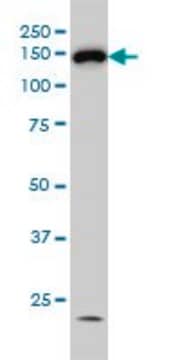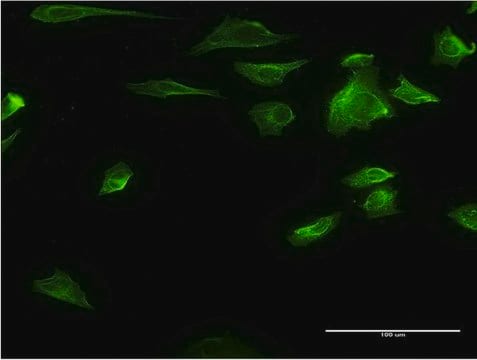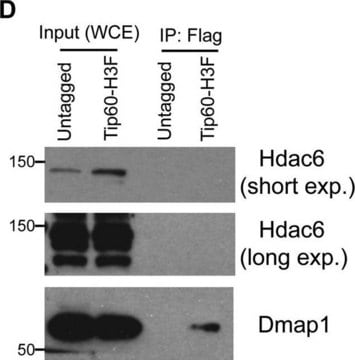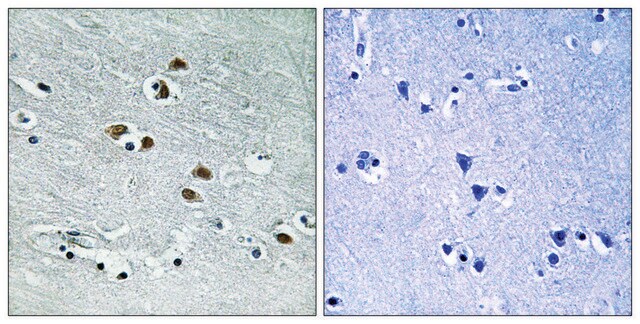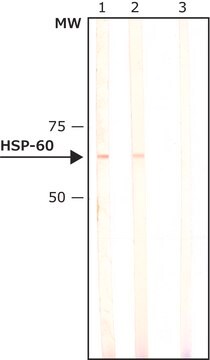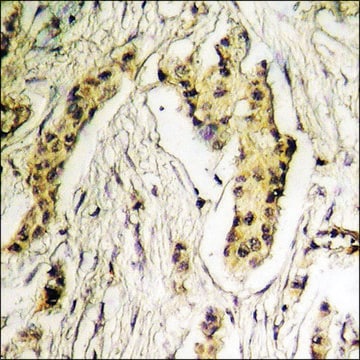추천 제품
생물학적 소스
rabbit
Quality Level
결합
unconjugated
항체 형태
IgG fraction of antiserum
항체 생산 유형
primary antibodies
클론
polyclonal
형태
buffered aqueous solution
분자량
antigen ~134 kDa
종 반응성
human, mouse
기술
immunoprecipitation (IP): 5-10 μg using RIPA extract of 500 μg of 293T cells expressing recombinant mouse HDAC6.
microarray: suitable
western blot: 1:1,000 using 293T cells expressing recombinant mouse HDAC6 in a chemiluminescent detection system.
UniProt 수납 번호
배송 상태
dry ice
저장 온도
−20°C
타겟 번역 후 변형
unmodified
유전자 정보
human ... HDAC6(10013)
mouse ... Hdac6(15185)
관련 카테고리
일반 설명
Anti-Histone Deacetylase 6 (HDAC6), is produced in rabbit using a synthetic peptide corresponding to amino acid residues 1199-1213 of human HDAC6. Mammalian HDACs can be divided into three classes according to sequence homology. Class I consists of the yeast Rpd3-like proteins HDAC1, HDAC2, HDAC3 and HDAC8. Class II consists of the yeast Hda1-like proteins HDAC4, HDAC5, HDAC6, HDAC7, HDAC9 and HDAC10. Class III consists of the yeast Sir2-like proteins. Class I HDACs are ubiquitously expressed, most class II HDACs are tissue-specific. Class II HDACs are larger than those of class I and their catalytic domain is located in the carboxy-terminal half of the protein. HDAC6 is a unique deacetylase among class II members in that it contains a duplicate of the catalytic domain in its NH2 terminus as well. The deacetylase activity of class II HDACs is regulated by subcellular localization. Endogenous HDAC6 is predominantly cytoplasmic where it associates with microtubules and functions as an a-tubulin deacetylase. HDAC6 contains a conserved zinc finger motif that is probably involved in the regulation of ubiquitination. The gene HDAC6 is mapped to human chromosome Xp11.23.
특이성
Anti-Histone Deacetylase 6 (HDAC6) recognizes human and mouse HDAC6 (~134 kDa). Detection of HDAC6 by immunoblotting is specifically inhibited with the immunizing peptide. Additional nonspecific bands of approx. 50 kDa may be detected in various extract preparations.
면역원
synthetic peptide corresponding to amino acid residues 1199-1213 of human HDAC6. The corresponding sequence in mouse differs by one amino acid.
애플리케이션
Anti-Histone Deacetylase 6 (HDAC6) recognizes human and mouse HDAC6 (~134 kDa). Applications include immunoblotting, immunoprecipitation, immunocytochemistry and immunohistochemistry.
Applications in which this antibody has been used successfully, and the associated peer-reviewed papers, are given below.
Immunohistochemistry (1 paper)
Western Blotting (1 paper)
Immunohistochemistry (1 paper)
Western Blotting (1 paper)
생화학적/생리학적 작용
Histone Deacetylase 6 (HDAC6) is an enzyme responsible for deacetylation of histones. HDAC6 is a part of transcriptional corepressor complexes. Overexpression or destruction of HDAC6 may lead to Alzheimer, Parkinson and cardiovascular diseases. Overexpression of HDAC6 is implicated in various cancers like malignant melanoma, lung and bladder cancer. It promotes tumorigenesis, cell migration and invasion. HDAC6 also regulates the expression of critical immune system molecules, targets of chemotherapy like programmed death receptor-1 (PD-1). Mutations in HDAC6 causes X-linked chondrodysplasia.
물리적 형태
Solution in 0.01 M phosphate buffered saline, pH 7.4, containing 15 mM sodium azide.
면책조항
Unless otherwise stated in our catalog or other company documentation accompanying the product(s), our products are intended for research use only and are not to be used for any other purpose, which includes but is not limited to, unauthorized commercial uses, in vitro diagnostic uses, ex vivo or in vivo therapeutic uses or any type of consumption or application to humans or animals.
Not finding the right product?
Try our 제품 선택기 도구.
시험 성적서(COA)
제품의 로트/배치 번호를 입력하여 시험 성적서(COA)을 검색하십시오. 로트 및 배치 번호는 제품 라벨에 있는 ‘로트’ 또는 ‘배치’라는 용어 뒤에서 찾을 수 있습니다.
이미 열람한 고객
The human histone deacetylase family
Gray SG and Ekstrom TJ
Experimental Cell Research, 262(2), 75-83 (2001)
Activation of autophagy in mesenchymal stem cells provides tumor stromal support
Sanchez CG, et al.
Carcinogenesis, 32(7), 964-972 (2011)
The class I-specific HDAC inhibitor MS-275 modulates the differentiation potential of mouse embryonic stem cells
Franci G, et al.
Biology Open, 2(10), 1070-1077 (2013)
Histone deacetylase 6 in cancer
Li T, et al.
Journal of Hematology & Oncology, 11(1), 111-111 (2018)
Ya Hui et al.
iScience, 27(1), 108689-108689 (2024-01-16)
High glucose has been proved to impair cognitive function in type 2 diabetes, but the underlying mechanisms remain elusive. Here, we found that high glucose increased transcription factors' SP1 O-GlcNAcylation in regulatory T (Treg) cells. Glycosylated SP1 further enhanced HDAC2
자사의 과학자팀은 생명 과학, 재료 과학, 화학 합성, 크로마토그래피, 분석 및 기타 많은 영역을 포함한 모든 과학 분야에 경험이 있습니다..
고객지원팀으로 연락바랍니다.